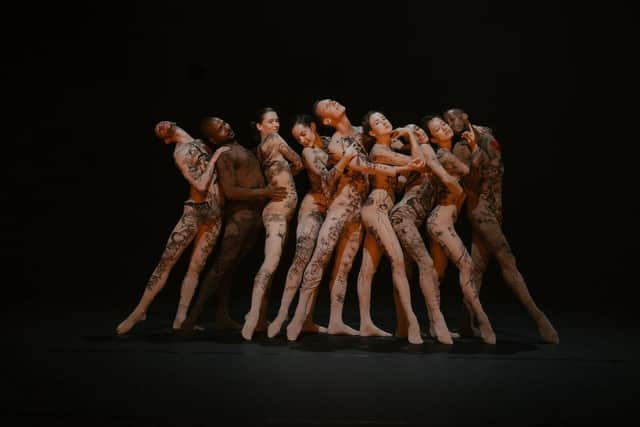Edinburgh International Festival reviews: Chapter 3: The Brutal Journey of the Heart | National Youth Choir of Scotland | Amatis Trio and Thomas Quasthoff
Chapter 3: The Brutal Journey of the Heart ****
Festival Theatre
To search for a specific meaning in contemporary dance is often a fool’s errand. This latest work from L-E-V dance company is inspired by human resilience and our ability to break and mend in response to life’s challenges. But if there’s a narrative to be found here, it’s in Sharon Eyal’s head rather than on the stage. So anyone who missed the first two parts of this trilogy (OCD LOVE and Love Chapter 2) can join the party without fear of confusion.
Choreographer Eyal and co-creator Gai Behar are known for building an atmosphere that’s akin to an underground nightclub. Lighting used sparingly but creatively, a beat that climbs inside your bones, and dancers who never stop moving, redolent of a pulsating swarm of bodies on a dancefloor. Picture that, but with performers whose every move pulls you in. This journey may be called ‘Brutal’, but not for us. Sixty minutes of movement by seven dancers who never leave the stage, never take a moment’s pause and, strange though it may seem, rarely lower their heels.
Advertisement
Hide AdAdvertisement
Hide AdOccasionally they separate and dance alone, spread across the large Festival Theatre stage. But for the most part they act as one, like a colony of creatures bound by a collective need to connect. Their costumes (identical patterned unitards by Christian Dior designer Maria Grazia Chiuri) add to the sense of community, and yet there is individuality here. Even when they’re dancing in unison, there is a sense of uniqueness.
Jerks and twists more reminiscent of insects and animals than humans give way to floating arms and high, stretched legs, blending aesthetic beauty with something more earthy. And always with that infectious beat driving the action on stage and our attachment to it. Kelly Apter
National Youth Choir of Scotland *****


Usher Hall
Ranking musical ensembles is, of course, deeply insidious. But it needs reiterating: the National Youth Choir of Scotland must surely be one of the nation’s finest music organisations. That much was evident from the Choir’s magnificent and all-too-short International Festival concert, at least, which combined piety, power and mischief to deeply moving effect.
Conductor (and NYCoS artistic director) Christopher Bell had clearly rehearsed and re-rehearsed every last detail of Britten’s madcap Rejoice in the Lamb and Duruflé’s sonic hug of a Requiem until the singers knew the pieces inside out. Their delivery was accordingly immaculate, but never calculated: there was a remarkable freshness, even spontaneity, as if they were discovering the music for the first time.
Under Bell’s detailed, demanding direction, they tackled Britten’s setting of Christopher Smart’s eccentric 18th-century poetry praising the holiness of cats, mice and letters of the alphabet with due reverence and respect rather than knowing humour – and impeccable enunciation, so that every word rang clearly. The Duruflé Requiem’s debt to medieval plainsong was clear in NYCoS’s winding lines, beautifully shaped by Bell and the young singers. Sensitive support came from the Royal Scottish National Orchestra, on vivid form itself, with Catriona Morison and Paul Grant as luxury soloists. It might have been barely an hour of music, but there was something to savour in every minute. David Kettle
Amatis Trio and Thomas Quasthoff ***
Queen’s Hall
It’s a funny old time in Edinburgh, with (to quote a cliché) high art from accomplished professionals at the International Festival, and rawer, rougher stuff on the Fringe. Does that mean different rules apply? Well, it shouldn’t. And, despite its laudable anti-war intentions and its generally strong performances, if the mix of World War I letters and bleeding chunks of music offered by the Amatis Trio and narrator Thomas Quasthoff found itself as a Fringe show, it would rightly be scrutinised and criticised for its patchy dramaturgical rigour, its rather self-evident insights, and its repurposing of music to illustrate narrative points, with varying degrees of relevance.
Despite his gloriously rich, velvety tones, Quasthoff’s delivery was surprisingly unconvincing, especially in the more colloquial English sections. And while the Amatis players gave vivid accounts of music from Schubert to Webern to Shostakovich (a particularly raw, rasping scherzo from the Second Piano Trio), there was a nagging question of the extent to which their interpretations had been reangled to illustrate the texts that came before them. To end with the conclusion – albeit Neville Chamberlain’s – that there are no winners, only losers in war felt unacceptably pat, certainly when there are so many challenging, provocative and illuminating works addressing similar subjects just a few feet down the road. All in all, problematic. David Kettle